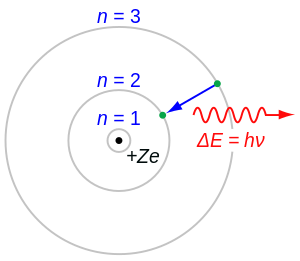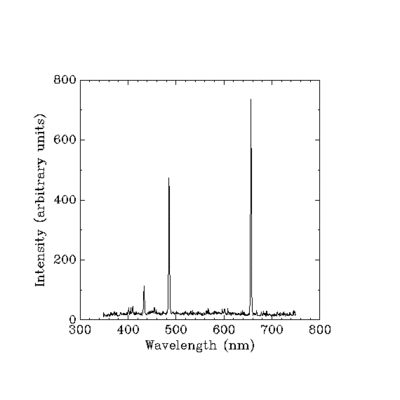General Astronomy/Molecular Emission and Absorption
Astronomical spectroscopy is one of the most powerful tools used by astronomers to gain a fundamental understanding of our universe. Astronomical spectroscopy is a technique in which the absorption and emission of electromagnetic radiation from stars and other celestial objects are studied. In order to be able to interpret and predict absorption and emission spectra from celestial bodies, one must have a fundamental understanding of molecular emission and absorption. Molecular emission and absorption is the process in which photons are emitted and absorbed when a molecule changes quantum energy states. By studying molecular emission and absorption, the chemical composition, physical properties, and velocities of astronomical objects may be measured.
Quantum Mechanics
[edit | edit source]One of the key concepts from quantum mechanics essential to the understanding of molecular absorption and emission is the fact that molecular energy is quantized. In other words, molecules can exist only in specific quantum states with each quantum state having a set amount of energy. The quantized energy stored in a molecule can be thought of as the sum of energy stored in three distinct modes: (1) rotation, (2) vibration, and (3) electronic:
Since the internal energy levels of the molecules are quantized, discrete differences in energy are observed when molecules change quantum states. These transitions correspond directly with the energy of emitted or absorbed photons in discrete spectra. As stated earlier, emission is the process by which a molecule changes quantum states from a higher to a lower quantum state by the release of a photon. Absorption, on the other hand, is the process in which a molecule changes quantum states from a lower energy level to a higher energy level by absorbing a photon.

The total change in energy associated with a molecular transition (emission or absorption), can be described by the following:
In this equation, is the energy of the photon which is equal to the difference in energy associated with the molecular transition between two quantum states, is the frequency of the corresponding electromagnetic wave, and h is Planck's constant. This relation, known as Planck's Law, is important because it links the concepts of thinking of radiation as both a particle and a wave. Figure 1. illustrates the concept of emission due to the electronic transition of electrons orbiting the nucleus of an atom. It should be noted that even though this picture shows electronic transitions for an atom, the same processes govern electronic transitions in molecules. Using Planck's Law, the total change of internal energy in a molecule can be described as:
This equation states that the total internal energy of a molecule is the sum of the changes in rotational, vibrational, and electronic energy. From quantum mechanics, it can be shown that the quantum energy levels for the different modes of internal molecular energy have different spacing. Electronic states are more widely spaced than vibrational states, which are more widely spaced than rotational states. Because of this different spacing, changes in the different modes of internal energy lead to absorption and emission of electromagnetic energy at different wavelengths. Changes in rotational energy lead to microwave transitions, changes in rotational and vibrational energy (vibrotational) lead to infrared transitions, and changes in rotational, vibrational, and electronic energy (rovibronic) result in ultraviolet transitions. It should be noted that changes in vibrational energy are often accompanied with changes in rotational energy and changes in electronic energy are often accompanied by changes in vibrational and rotational energy.
Emission and Absorption Spectra
[edit | edit source]The absorption and or emission spectra of a molecule generally consist of a number of "lines". These lines correspond to the discrete differences in the internal energy modes of a molecule. In other words, a line is the part of a spectrum that corresponds to a transition from one quantum state to another. Groups of lines can in turn comprise a vibrational band. The positions, strengths, and shapes of lines can give accurate physical characteristics about the molecules undergoing internal energy transitions. The position of spectral lines reveals various molecular parameters such as internuclear spacing and molecular bond angles. Line strengths and shapes, on the other hand, can reveal the composition, temperature, pressure, and velocity of molecules in a radiating gas. This concept is illustrated in figure 2 which shows the emission spectra of hydrogen plasma.

The governing law for absorption spectroscopy that links various molecular properties with the amount of light absorbed in a gas medium is known as Beer's Law.
In this equation, is the fraction of light transmitted through a gas medium, is the frequency of the EM radiation being transmitted, is the spectral absorption coefficient, and L is the absorption path length. A diagram of Beer-Lambert absorption is presented in Figure 3. The spectral absorption coefficient is given by:
where is the "strength" of the transition, is the "lineshape function", and is the partial pressure of the absorbing gas species.
Diatomic Molecular Spectra
[edit | edit source]The interaction electromagnetic radiation has with matter can be explained through three main types of interactions: electronic dipole moment, induced polarization, and elastic scattering. Interactions with the electric dipole moment result in changes in the absorption and emission of radiation while induced polarization and elastic scattering are a direct result of how a molecule scatters photons. Many diatomic heteronuclear molecules have a permanent dipole. A dipole has a positive charge on one end and a negative charge on the other end of the molecule. The motion of this dipole, through the rotation and vibration of the molecule, allows the molecule to emit or absorb electromagnetic radiation.
Molecular Rotations
[edit | edit source]As stated earlier, rotations of molecules correspond to transitions in the microwave region of the EM spectrum. When a diatomic molecule rotates, the molecule's dipole moment also rotates, which allows for the absorption or emission at characteristic resonance frequencies. The simplest rotational model for a diatomic molecule describing this process is the rigid rotor approximation. In this model, the atoms of the molecules are point masses with an equilibrium separation distance that is either constant or rigid. Using classical mechanics, the moment of inertia and angular momentum of a molecule can be determined. This information used in conjunction with the molecule's rotational energy allows one to determine the allowed values of rotational energy as a function of quantum number.
Molecular Vibrations
[edit | edit source]Much as rotations of a molecule can lead to changes in the electric dipole of a molecule, vibrations can also change the electric dipole of a molecule due to stretching of the molecule's internal bonds. This stretching leads to the possibility of emission or absorption of infrared EM radiation. The simplest model for diatomic vibration is the simple harmonic oscillator. In this model, two masses are separated by an equilibrium separation distance. The bond length between the two masses oscillates about this equilibrium distance much like a spring. By using classical mechanics, the fundamental resonant frequency, which is characterized by the bond stiffness and magnitude of the masses, can be used to determine the potential energy stored in the oscillator.
Electronic Transitions
[edit | edit source]In addition to rotations and vibrations, a molecule's electronic structure can also interact with EM radiation. If the distribution of electrons in a molecule's shell is changed, energy transitions occur which result in emission and absorption of EM radiation in the ultraviolet and visible regions of the electromagnetic spectrum. Electronic spectra involve the transitions that occur between the potential energy wells which correspond to different electronic configurations. The potential wells represent the variation of electronic forces with internuclear spacing.
Quantum Numbers
[edit | edit source]There are multiple quantum numbers that define the state of each electron: the principal quantum number representing the electrons energy level, the azimuthal (or angular momentum) quantum number denoting the subshell of the electron (i.e. s,p,d,f), the magnetic quantum number specifying the orbital within the subshell, and the spin quantum number defining the spin of the electron (spin up or down).
| Name | Symbol | Meaning | Possible Values |
|---|---|---|---|
| Prinicipal quantum number | n | Energy level of the electron | |
| Azimuthal (angular momentum) quantum number | Subshell of the electron (corresponds to s, p, d, f) | ||
| Magnetic quantum number | m | Orbital within the subshell | |
| Spin quantum number | s | Spin of the electron |
There is also the total angular momentum number: .





















